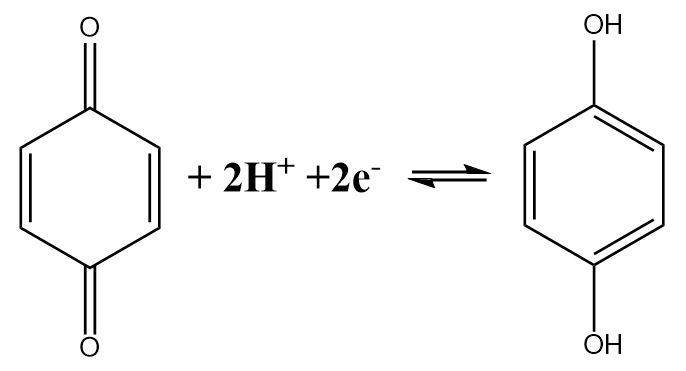
Answer
369k+ views
Hint: The quinhydrone electrode is a special electrode used to measure the hydrogen ion concentration and pH of a particular solution. The half-cell reaction involving the quinhydrone electrode itself involves the hydrogen ions and is therefore used for the purpose of determining the pH of solutions.
Complete answer:
The molecular crystal formed between the Quinone \[(Q)\] and hydroquinone \[(Q{H_2})\] is known as quinhydrone. The dissolution of quinhydrone crystals into water initiates the decomposition process and the molecule breaks down into its constituent fragments and one of these constituents are the hydrogen ions.
The electrode contains a golf wire in the spiraled form that is dipped into the solution of unknown hydrogen ion concentration or the solution whose pH needs to be determined.
The electrode potential of any cell can be expressed in the terms of its standard electrode potential \[({E^ \circ })\] and the concentrations of the reactants and the products.
The half-cell reaction of a quinhydrone electrode indicates the fact that a Quinone molecule accepts two electrons and gets reduced in the process. The reaction can be written as follows:

The expression for the reduction potential can be given as follows:
\[E = {E^ \circ } - \dfrac{{2.303RT}}{{2F}}\log \dfrac{{[Q{H_2}]}}{{[Q]{{[{H^ + }]}^2}}}\]
Which can be written as,
\[E = {E^ \circ } - \dfrac{{2.303RT}}{{2F}}\log \dfrac{1}{{{{[{H^ + }]}^2}}}\]
The negative log of concentration of hydrogen ions is nothing but pH and therefore the expression can be rewritten as follows:
\[E = {E^ \circ } - \dfrac{{2.303RT}}{F}pH\]
Assuming that the temperature is room temperature and putting in the stand values of Faraday’s constant and universal gas constant we get,
\[E = {E^ \circ } - (0.0591 \times pH)\]
Since, the standard electrode potential is given to be \[1.30V\] and the pH is given to be three, these values can be inserted in the above formula to get the final electrode potential,
\[E = 1.1227V\]
Which can be approximated to,
\[E \approx 1.10V\]
Hence, option (c) is correct.
Note:
Since, the activities of Quinone and hydroquinone remain equal in the reaction, their concentration terms get cancelled in the expression of electrode potential calculations. The activity of hydrogen ions is assumed to be approximately equal to its concentration i.e. the activity coefficient is taken to be one for the simplification of calculations.
Complete answer:
The molecular crystal formed between the Quinone \[(Q)\] and hydroquinone \[(Q{H_2})\] is known as quinhydrone. The dissolution of quinhydrone crystals into water initiates the decomposition process and the molecule breaks down into its constituent fragments and one of these constituents are the hydrogen ions.
The electrode contains a golf wire in the spiraled form that is dipped into the solution of unknown hydrogen ion concentration or the solution whose pH needs to be determined.
The electrode potential of any cell can be expressed in the terms of its standard electrode potential \[({E^ \circ })\] and the concentrations of the reactants and the products.
The half-cell reaction of a quinhydrone electrode indicates the fact that a Quinone molecule accepts two electrons and gets reduced in the process. The reaction can be written as follows:

The expression for the reduction potential can be given as follows:
\[E = {E^ \circ } - \dfrac{{2.303RT}}{{2F}}\log \dfrac{{[Q{H_2}]}}{{[Q]{{[{H^ + }]}^2}}}\]
Which can be written as,
\[E = {E^ \circ } - \dfrac{{2.303RT}}{{2F}}\log \dfrac{1}{{{{[{H^ + }]}^2}}}\]
The negative log of concentration of hydrogen ions is nothing but pH and therefore the expression can be rewritten as follows:
\[E = {E^ \circ } - \dfrac{{2.303RT}}{F}pH\]
Assuming that the temperature is room temperature and putting in the stand values of Faraday’s constant and universal gas constant we get,
\[E = {E^ \circ } - (0.0591 \times pH)\]
Since, the standard electrode potential is given to be \[1.30V\] and the pH is given to be three, these values can be inserted in the above formula to get the final electrode potential,
\[E = 1.1227V\]
Which can be approximated to,
\[E \approx 1.10V\]
Hence, option (c) is correct.
Note:
Since, the activities of Quinone and hydroquinone remain equal in the reaction, their concentration terms get cancelled in the expression of electrode potential calculations. The activity of hydrogen ions is assumed to be approximately equal to its concentration i.e. the activity coefficient is taken to be one for the simplification of calculations.
Recently Updated Pages
Who among the following was the religious guru of class 7 social science CBSE

what is the correct chronological order of the following class 10 social science CBSE

Which of the following was not the actual cause for class 10 social science CBSE

Which of the following statements is not correct A class 10 social science CBSE

Which of the following leaders was not present in the class 10 social science CBSE

Garampani Sanctuary is located at A Diphu Assam B Gangtok class 10 social science CBSE

Trending doubts
Which are the Top 10 Largest Countries of the World?

In what year Guru Nanak Dev ji was born A15 April 1469 class 11 social science CBSE

A rainbow has circular shape because A The earth is class 11 physics CBSE

How do you graph the function fx 4x class 9 maths CBSE

Fill the blanks with the suitable prepositions 1 The class 9 english CBSE

In Indian rupees 1 trillion is equal to how many c class 8 maths CBSE

The Equation xxx + 2 is Satisfied when x is Equal to Class 10 Maths

Why is there a time difference of about 5 hours between class 10 social science CBSE

Difference between Prokaryotic cell and Eukaryotic class 11 biology CBSE





